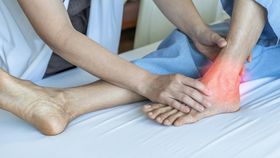Upstep Answers
Our team answers your questions about the causes and treatment of various podiatric conditions, including plantar fasciitis, flat feet, foot pain, and the use of custom orthotics.
Recent Answers
What Causes Pain in the Top of Your Foot After Running?
Pain in the foot is uncomfortable, relatively common, and can manifest in any area of the foot, including the top. Here are the most common causes of pain on the top of your foot, home remedies, and w
Asked 4 years ago
How Long Does It Take To Recover From Metatarsalgia?
Sometimes, pain occurs in the ball of the foot. This is known as metatarsalgia and is a result of inflammation around the head of the metatarsals. It can also present with numbness, stiffness, and swe
Asked 4 years ago
How to Relieve Foot and Leg Pain From Standing All Day
Many people who have to stand for an extended period daily experience aching feet at night. When not addressed, the complications of prolonged standing can be overwhelming. Here's why your feet hurt,
Asked 4 years ago
How Long Does It Usually Take to Adjust to and Break in a New Orthotic?
When you get new orthotics to deal with any foot malaises you may have, you set in motion a process of restoration. Unfortunately, for many, this initial restoration process causes discomfort, pain, a
Asked 4 years ago
What Happens if You Stop Wearing Your Orthotics?
According to professional instruction, orthotics are meant to be worn all the time as they address the foot function rather than the foot itself. Therefore, you shouldn't stop wearing your orthotics j
Asked 4 years ago
Related Articles

Heel Pain and Golf
Upstep Staff
October 7, 2024

Posterior Tibial Tendonitis: Symptoms, Causes, & Treatments
Babafemi Adebajo
February 17, 2023

6 Expert Tips to Get Better at Pickleball: From Beginner to Pro
Katie Van Doren
December 5, 2024

How to Support Your High Arches & Why It Matters
Jasrah Javed
August 19, 2024

Weightlifting with Flat Feet: Challenges and Solutions
Jasrah Javed
October 14, 2024
Recent Posts
Babafemi Adebajo
Persistent Shin Splints: Why Won’t They Go Away?
Babafemi Adebajo
Vitamins for Shin Splints: Choose the Right Supplements
Babafemi Adebajo
7 Best Orthotics to Aid With Your Lower Back Pain
Babafemi Adebajo
Best Insoles for Plantar Fibroma
Babafemi Adebajo
Out-Toeing—Symptoms, Causes, and Treatments
Janik Sundstrom



